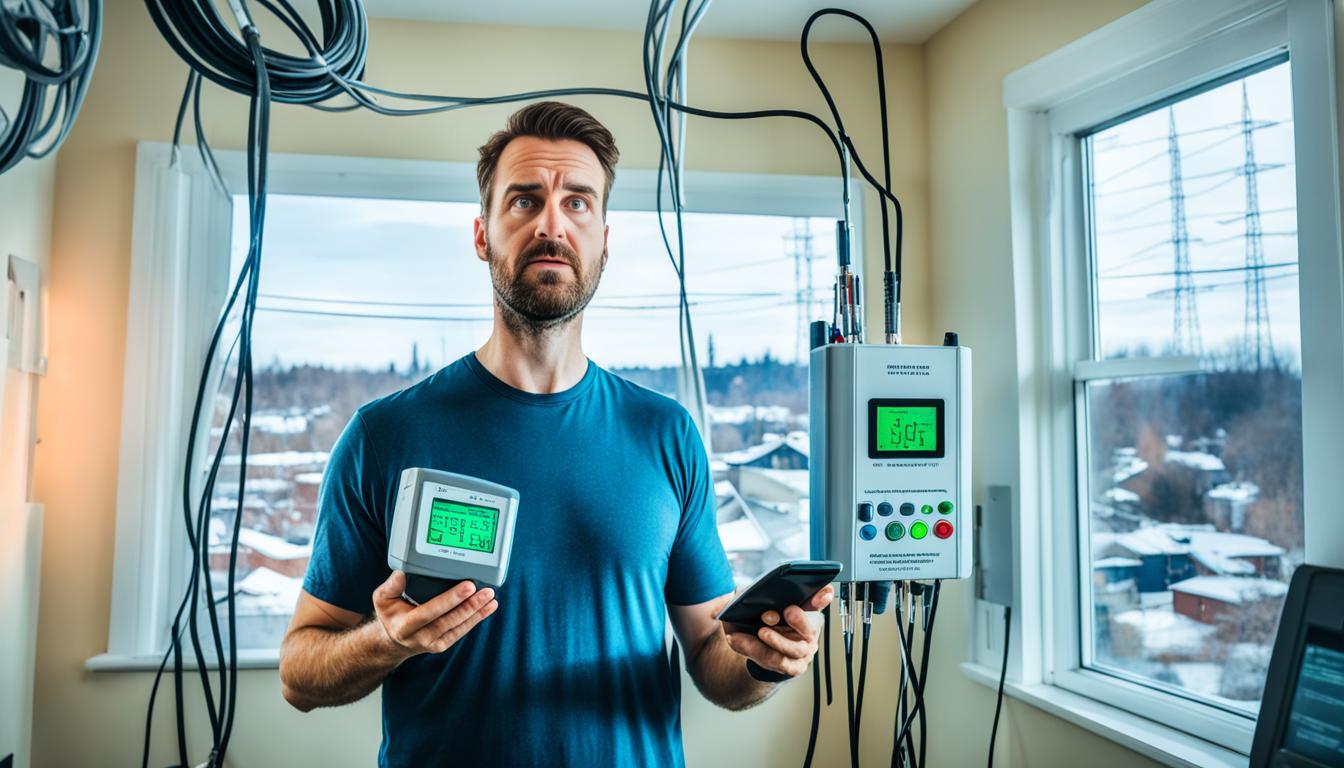Disclosure: This Post Contains Affiliate Links; We earn a commission on purchases.
Electric and magnetic fields (EMFs) are both naturally occurring and generated by human-made sources. These fields are a type of radiation, commonly known as EMF radiation, that can be found in our everyday environment. While low-frequency EMFs are generally considered to pose little danger to human health, there is still ongoing discussion and research regarding the potential health effects of EMF exposure.
EMFs are produced by a variety of sources including power lines, cellphones, microwaves, Wi-Fi routers, and electrical appliances. It’s important to understand the types of EMF exposure, the differences between ionizing and non-ionizing radiation, and the potential health risks associated with different levels of exposure.
Key Takeaways:
- EMFs are both naturally occurring and produced by human-made sources.
- Low-frequency EMFs are generally considered safe, but ongoing research is being conducted.
- Sources of EMF radiation include power lines, cellphones, Wi-Fi routers, and electrical appliances.
- There are different types of EMF radiation, including ionizing and non-ionizing.
- Understanding EMF exposure and its potential health effects is important for practicing EMF safety.
Types of EMF Exposure and Radiation
When it comes to EMF exposure, it’s important to understand the different types of radiation that individuals may come into contact with. There are primarily two types of electromagnetic fields (EMFs) that people may be exposed to: ionizing radiation and non-ionizing radiation.
Ionizing Radiation
Ionizing radiation is high-frequency EMF that carries enough energy to remove tightly bound electrons from atoms, causing ionization. This type of radiation includes X-rays, gamma rays, and certain high-energy ultraviolet (UV) rays.
Ionizing radiation is commonly used in medical imaging, such as X-rays and CT scans, to diagnose and treat various conditions. However, prolonged exposure to high levels of ionizing radiation can be harmful to human health, including an increased risk of cancer and DNA damage.
Non-Ionizing Radiation
Non-ionizing radiation refers to low- to mid-frequency EMF that does not carry enough energy to ionize atoms. This type of radiation is generally considered to be less harmful than ionizing radiation.
Non-ionizing radiation includes extremely low-frequency (ELF) radiation and radiofrequency (RF) radiation. ELF radiation is emitted by power lines, electrical appliances, and some industrial equipment. RF radiation is emitted by wireless devices such as cellphones, Wi-Fi routers, and Bluetooth devices.
While non-ionizing radiation is generally considered to be safe, prolonged exposure to high levels of RF radiation can potentially cause thermal effects, which can lead to tissue damage. The potential health effects of long-term, low-level exposure to non-ionizing radiation are still a subject of ongoing research and debate.
Summary
In summary, individuals may be exposed to two types of EMFs: ionizing radiation and non-ionizing radiation. Ionizing radiation is high-frequency and can have harmful effects on human health, while non-ionizing radiation is low- to mid-frequency and is generally considered to be less harmful. It’s important to be aware of the sources of these types of radiation and the potential health effects associated with each.
Sources of EMF Radiation
Exposure to electromagnetic fields (EMFs) can come from various sources, both natural and man-made. It’s important to be aware of these sources and understand the potential risks associated with EMF radiation.
Non-Ionizing Radiation Sources
Non-ionizing radiation refers to EMFs with lower energy levels that do not cause ionization or the removal of electrons from atoms. Some common sources of non-ionizing radiation include:
- Microwave ovens: These appliances emit EMFs when in use. It’s best to maintain a safe distance from the microwave while it is operating to minimize exposure.
- Computers: Laptops, desktops, and other electronic devices emit EMFs. Reduce exposure by increasing the distance between yourself and the device, using a wired connection instead of Wi-Fi, and taking breaks from prolonged use.
- Wireless routers: Wi-Fi routers emit EMFs to enable wireless internet connectivity. Place the router away from heavily frequented areas, such as bedrooms or living rooms, to minimize exposure.
- Cellphones: Mobile phones emit radiofrequency EMFs. Reduce exposure by using speakerphone or a wired headset, texting instead of calling when possible, and keeping the phone away from your body when not in use.
- Power lines: Overhead power lines can emit low-frequency EMFs. While it’s challenging to avoid exposure, maintaining a safe distance and limiting time spent near power lines can help.
- MRI machines: Magnetic Resonance Imaging (MRI) machines generate strong magnetic fields, exposing individuals during medical procedures. Strict safety protocols are followed in medical settings to minimize any potential harm.
Ionizing Radiation Sources
Ionizing radiation has higher energy levels and can cause ionization, potentially damaging cells and DNA. Some sources of ionizing radiation include:
- X-rays: Medical imaging procedures such as X-rays expose individuals to ionizing radiation. These procedures should only be performed when medically necessary, with appropriate protective measures in place.
- Gamma rays: Gamma rays are emitted during radioactive decay and nuclear reactions. Strict safety protocols are followed in industries and research settings that deal with gamma radiation.
- UV radiation: Ultraviolet (UV) radiation from the sun or artificial sources can cause skin damage and increase the risk of skin cancer. Protect yourself by wearing sunscreen, sunglasses, and appropriate clothing when exposed to sunlight.
Understanding the sources of EMF radiation is the first step in minimizing exposure and promoting overall well-being. By implementing safety measures and practicing EMF awareness, you can reduce your risk of potential health effects.

Stay informed about the latest research, guidelines, and technological advancements related to EMF exposure to make informed decisions and protect yourself and your loved ones.
Research on EMF Health Effects
The research on the health effects of electromagnetic field (EMF) exposure is ongoing and continues to be a topic of debate and discussion among scientists and organizations. One prominent organization that has investigated the connection between EMFs and human health is the International Agency for Research on Cancer (IARC).
The IARC classification:
The IARC has classified non-ionizing EMFs in the radiofrequency range as a possible human carcinogen.
Several studies have explored the potential links between EMFs and cancer, particularly regarding radiofrequency (RF) radiation. These studies suggest that long-term, low-level exposure to RF radiation may increase the risk of certain types of cancer, such as glioma and leukemia.
Moreover, research has also been conducted to investigate any potential connections between EMFs and specific health conditions. Some studies have found evidence of a possible link between EMF exposure and neurological and psychiatric problems, although more research is needed to fully understand the extent and mechanisms of these effects.

While the findings of these studies provide valuable insights, it is essential to approach the topic with caution and continue conducting rigorous research to corroborate and expand on these initial findings. Understanding the potential health risks associated with EMF exposure is crucial for individuals, policymakers, and healthcare professionals alike.
Conclusion
As the ongoing research and debate about the potential health effects of EMF exposure continues, it is crucial to prioritize EMF safety and protection. Minimizing exposure to sources of EMF radiation and following recommended safety guidelines can play a significant role in safeguarding your well-being. Additionally, using EMF shielding devices can provide an extra layer of protection against the potential risks of EMF exposure.
Staying informed about the latest research and guidelines is essential for making informed decisions regarding EMF exposure and protection. By staying up to date, you can take proactive measures to ensure the safety of yourself and your loved ones in relation to EMF exposure. As EMF safety and the protection of individuals remain topics of research and public interest, it is important to prioritize your well-being by implementing precautionary measures.
Remember, while the complete understanding of the potential health effects of EMF exposure may still be evolving, taking steps to reduce exposure and practice EMF safety can provide peace of mind. By incorporating recommended safety measures into your daily routine, you can mitigate potential risks and contribute to a healthier environment for yourself and those around you.
Source Links
- https://www.healthline.com/health/emf
- https://www.who.int/news-room/questions-and-answers/item/radiation-electromagnetic-fields
- https://www.niehs.nih.gov/health/topics/agents/emf

Subscribe to Our Newsletter










